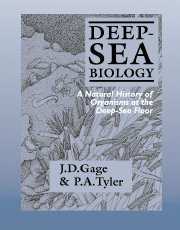Book contents
- Frontmatter
- Contents
- Preface
- Acknowledgements
- PART I The development of deep-sea biology, the physical environment and methods of study
- PART II Organisms of the deep-sea benthic boundary
- PART III Patterns in space
- PART IV Processes: patterns in time
- PART V Parallel systems and anthropogenic effects
- References
- Species index
- Subject index
PART V - Parallel systems and anthropogenic effects
Published online by Cambridge University Press: 05 June 2012
- Frontmatter
- Contents
- Preface
- Acknowledgements
- PART I The development of deep-sea biology, the physical environment and methods of study
- PART II Organisms of the deep-sea benthic boundary
- PART III Patterns in space
- PART IV Processes: patterns in time
- PART V Parallel systems and anthropogenic effects
- References
- Species index
- Subject index
Summary
As if to underline how little of the deep ocean has been explored, deep-sea scientists were astounded by the unexpected discovery in 1977 of a remarkable assemblage of large-sized, bizarre-looking creatures entirely different in life-style from the fauna of the rest of the deep sea as it had become (and largely remains) known. This fauna constituted concentrations of biomass (ranging from 10 to 70 kg m-2 wet weight) many orders of magnitude greater than that supported by the deep-sea floor nearby. These clearly productive, but isolated, faunal ‘oases’ consist of giant-size bivalved molluscs and strange red-plumed tubeworms clustering around the newly discovered hydrothermal vents at 2.8 km depth on the Galapagos Rift, a spreading centre in the equatorial eastern Pacific. What's more surprising is that these creatures subsist on organic matter originating, not from the sun-driven photosynthetic production going on at the surface of the ocean, but from chemosynthetic microbes, some of them living as symbionts within their body tissues that use as energy-providing substrates inorganic chemicals such as sulphur derived from the bowels of the earth.
There have been many more recent discoveries of similar faunas associated with other forms of submarine seepage, along with a realization of similarities with biochemical systems in biota within the reducing conditions of highly organic sediments, where energy is obtained by utilizing electron acceptors other than oxygen.
- Type
- Chapter
- Information
- Deep-Sea BiologyA Natural History of Organisms at the Deep-Sea Floor, pp. 361 - 362Publisher: Cambridge University PressPrint publication year: 1991

